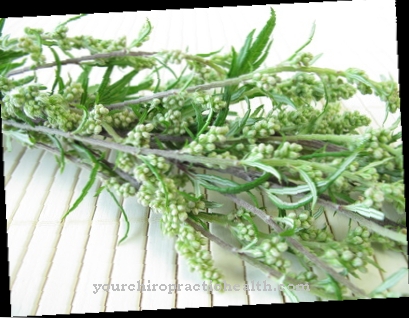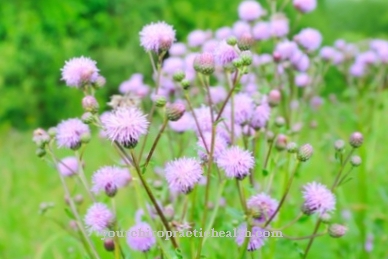Of the Common wolfberry belongs to the nightshade family and is assigned to the genus of the buckthorn. The original home of this plant is China, where it is widely used as a medicinal plant. Your fruit is as Goji berry known.
Occurrence and cultivation of the common wolfberry

Originally the Common wolfberry from China, where it is widely used as a medicinal plant, especially because of its fruits. As a so-called neophyte, the plant then spread to other parts of the world as a cultivated plant. In Germany it thrives especially on fences or walls, mostly in the vicinity of eastern German cities. It is found less often in West Germany. The plant does not tolerate soils that are rich in salt or contaminated with heavy metals.
In the southern countries, the common wolfberry is often found in the wild because it was often used there to plant dams or as an ornamental plant. Also called Common wolfberry, Common devil thread or Chinese wolfberry designated plant is a two to four meter high growing deciduous shrub. Its prickly, arched branches have elongated gray-green leaves. The common wolfberry blooms from June to August and sometimes into September.
Effect & application
As already mentioned, the common wolfberry is used as a medicinal plant, especially in China. There it is often used for cooking. Its fruit is known as the goji berry and is often eaten cooked or raw. The fruits are harvested in summer and autumn. After the harvest, they are dried in the sun and then processed. The leaves of young plants are often used to prepare leafy vegetables.
In Europe, fruit juices are often sold that are made from the goji berry and are said to have a variety of health effects. The berries are stored frozen or dried. The common wolfberry is also used as an ornamental plant or as a shrub for dam planting. Research has shown that the goji berries, like many other fruits and vegetables, have a variety of positive health effects.
A suggestion made towards the end of the nineteenth century that the common wolfberry was poisonous has not been confirmed. The toxicity of the plant is said to come from its hyoscyamine content, a poisonous alkaloid. However, no hyoscyamine was found. For this, the plant contains important ingredients that are of great health importance. Its ingredients zeaxanthin and lutein are said to have important medicinal effects.
In particular, it is postulated that extracts from the common wolfberry protect against the destruction of the optic nerve in the presence of glaucoma. Furthermore, the polysaccharides contained in the plant should strengthen the immune system. According to some studies, the aqueous extract of common wolfberry is said to have a strong antioxidant effect. An efficacy against cancer is suspected, but has not yet been verified.
To what extent goji berries have ingredients that counteract oxidative stress and can effectively intercept free radicals, further studies have yet to prove. However, according to the European food safety authority EFSA, there is currently insufficient evidence for this. On the other hand, according to the Federal Institute for Risk Assessment, there is no evidence of any harmful effects from goji berries.
However, their consumption with simultaneous intake of vitamin K antagonists, such as Marcumar, can intensify the blood-thinning effect, so that heavy bleeding that is difficult to control cannot be ruled out. In general, however, the beneficial medicinal effects of common wolfberry can be expected to outweigh the benefits.
Importance for health, treatment & prevention
The common wolfberry and especially its fruit, the goji berry, are said to have healing effects against many physical and psychological ailments. This is how the regulating effect of goji berries on the immune system was described. As a result, diseases such as allergies or autoimmune diseases can be successfully treated with their help. Goji berries are also said to have a positive effect on the intestinal flora.
Intestinal rehabilitation can be supported by taking them. The carotenoids zeaxanthin and lutein contained in the goji berry also strengthen the performance of the eyes and protect the optic nerves from being destroyed in glaucoma. Furthermore, it was found that the berries can also slightly lower blood sugar levels, which opens up very interesting prospects for diabetics. The positive effect of the fruit on blood pressure has also been described.
Inflammatory processes in the body are alleviated so that the berries can also be used to support cancer. Protection against cancer was suspected, but could not yet be clearly proven. Since goji berries also have a filling effect, they are used, among other things, in dietary supplements. However, they do not work miracles here, but could help to change eating behavior in the long term.
The polysaccharides of the goji berries also strengthen the performance of the muscles, so that they are very popular with athletes. There is even evidence that the fruit can also help with mental health problems. That is why they also support therapies for depression, fatigue and burnout today. The minerals contained in the berries strengthen the nerves and increase the ability to concentrate.
The application of the goji berries is very easy. Goji juices, which have a high fruit content, are particularly popular. Goji teas, goji capsules and dried or fresh goji berries are also available in stores. Overall, the common wolfberry and especially its fruits have good therapeutic, supportive and preventive effects.

















.jpg)







.jpg)


